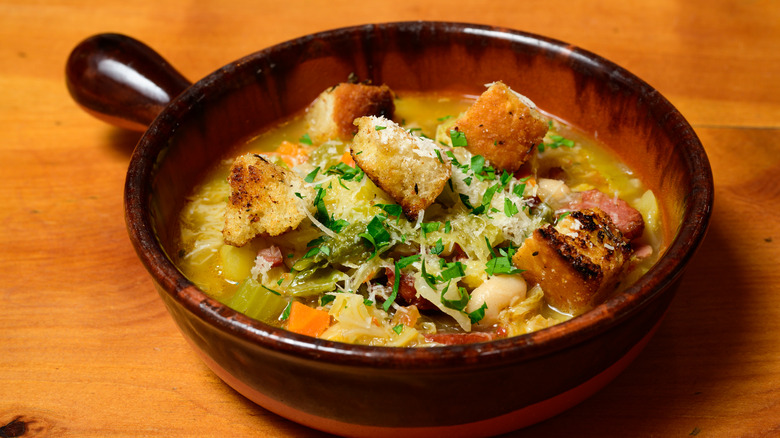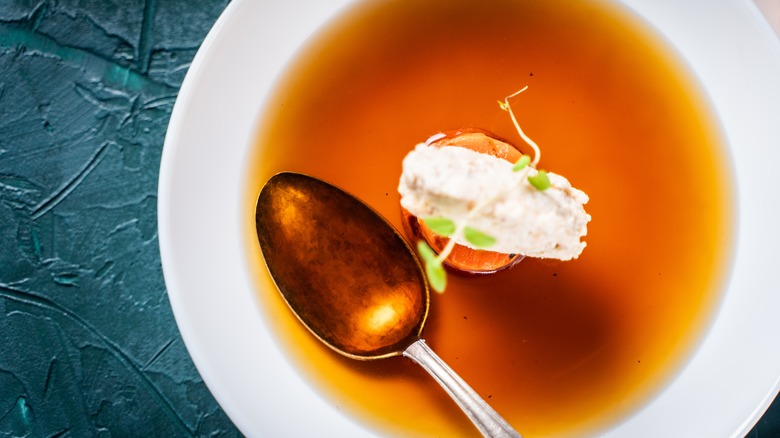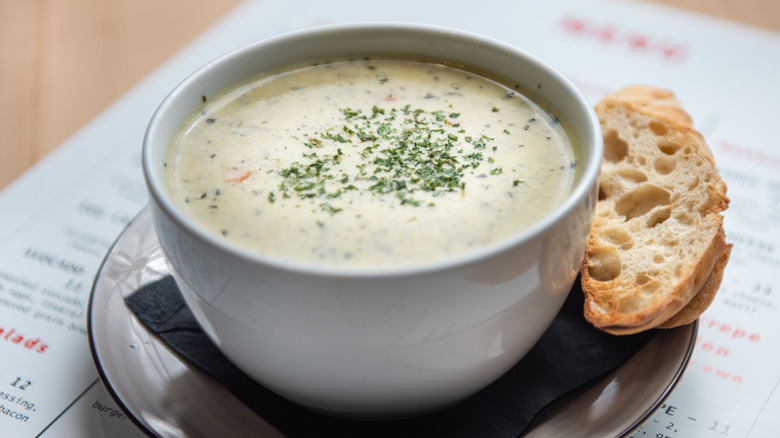Vintage Soups We Miss Seeing On Restaurant Menus
Soups have been an essential component of restaurant menus since public eateries have existed, not just in the United States, but globally. It is a little known fact that the very first restaurant, a Parisian-set establishment that opened in 18th century France, served only soup. Soup remains a timeless offering, being enjoyed in all manner of restaurants and regional venues, from neighborhood cafes to authentic Japanese restaurants.
These liquid delights can be brothy and basic, thick and stew-like, existing as a simple appetizer or standing as the main course itself. While some seem to remain eternal, such as the everlastingly popular chicken noodle soup, others have vanished from restaurant menus, becoming lost in the faded pages of bygone cookbooks and memories. It is time to peer back into eatery offerings of the past, examining the reasons these soups have waned in popularity or sadly occasionally disappeared altogether from restaurant menus.
Split pea and ham
Split pea and ham soup is a savory dish that seems to have departed from the vast majority of American menus over the years. Often cooked with a ham bone for extra flavor or bacon, this soup is both earthy and tremendously filling. Made from dried split peas and slowly simmered with various fresh vegetables and spices, this fare is one that has existed for centuries, crossing continents in the process.
Once considered a dish for poorer families in the 19th century due to the low cost of dried peas and their ease of storage, it is rarely seen in restaurants these days outside of California's one and only remaining Pea Soup Andersen's in Santa Nella. A long-beloved pitstop to those driving up and down the California coast, this old-fashioned eatery has closed numerous locations over the years, likely due in part to changing consumer tastes.
Still, those who lament the disappearance of this hearty soup from restaurant menus can easily craft their own version at home using a leftover holiday ham bone, dried peas, and vegetables. Vegetarian versions can be made, as well, substituting paprika for the ham bone to recreate the smoky taste associated with this classic soup.
Gazpacho
Cold soups like gazpacho seem to be all but completely forgotten in modern-day cuisine. This chilled soup made from tomatoes, garlic, and various vegetables all puréed together was wildly popular in America during the 1960s, with adoration spanning from New York all the way to California. The dish had actually existed in America for quite some time by then. Early gazpacho recipes in America date back to the 1800s, yet this Andalusian-born soup didn't catch on until the mid-1900s when it was heralded as an optimal summer foodstuff.
During this time, gazpacho was once considered the ideal soup of the sweltering season, pairing exceptionally well with hot weather and lighter fare. Deviating from the original Spanish recipe, which often included bread, olive oil, and vinegar, American adaptations of this refreshingly cold soup simplified the recipe, often adding fresh takes on this classic dish.
Although most consider tomatoes to be the core of gazpacho, other versions have cropped up over the years, such as those including avocado, cucumber, and even watermelon. Some of these incarnations seem more akin to smoothies than Spain's original creation, leading us to wonder if this chilled soup didn't disappear so much from menus, but was rather replaced by blended drinks as a preferred summer refresher.
Navy bean soup
Navy bean soup, also known as Senate bean soup, is rarely seen on restaurant menus these days, unless you're dining at one of the Senate Restaurants. Believed to have been born sometime in the 20th century, the soup has remained a fixture in the U.S. Senate cafeteria for more than 100 years, starting when a Senator demanded the soup be offered daily on the menu. Using mainly white beans as its foundation, this core ingredient acquired the name "Navy beans" after being used as a ration for the U.S. Navy. Classic variations of this soup include versions made with tomatoes, ham hocks, or occasionally even mashed potatoes, rendering this soup a filling offering that is high in protein.
However, the soup seems to rarely make a menu appearance these days outside of the Senate's eateries. Why this soup has seemingly fallen from grace remains a mystery, but it is possibly due to changing tastes as consumers developed broader palates and a desire for more diverse flavors. Early 20th century diners were far less adventurous with their culinary tastes, tending to eat what was common in their community and culture. As the years went on, appetites evolved as individuals were exposed to more diverse offerings introduced by immigrant populations.
Italian wedding soup
Despite what the name might imply, Italian wedding soup has no connection to marital vows and isn't served on one's wedding day. This Italian-bred soup began as a peasant dish, designed to keep folks full at a minimal cost. However, the soup evolved as it crossed the Atlantic, becoming lighter and less stew-like. Known as minestra maritata in its country of origin, meaning "married soup," the name refers not to where the soup is typically served, but the marriage of ingredients. Assembled from meatballs, greens, and tiny pasta like acini di pepe or orzo, this classic soup has seemed to dissipate from American menus with passing years, becoming far less frequent than it once was.
Those hoping to try this perfect union of greens and meatballs won't see it offered at standard establishments such as Olive Garden. Nowadays, you're more likely to find the dish in more traditional Italian restaurants, particularly in cities with a strong Italian-American heritage such as Pittsburgh or New York City. It has also remained a cherished item in Western Pennsylvania and Northeastern Ohio, likely due to many Italian families settling in these two states.
Turtle soup
While eating turtle may sound strange today, this reptile was once considered the epitome of luxury cuisine in the middle of the 1800s, being so acclaimed as to show up on the menu of the White House. Although many presidents were known to consume the delicacy, it was a particular favorite of President Taft, who hired a special chef to prepare the dish for him. During this era, turtle soup was seen everywhere from New York to Louisiana, being offered on high-end menus in Philadelphia, Baltimore, and San Francisco. Made from cream, butter, and either sherry or Madeira wine, this soup is rarely found on restaurant menus outside of New Orleans today, although it was previously a common dish across the United States.
There are many reasons turtle soup is no longer seen on contemporary menus, the most prominent being dwindling turtle populations due to these former foodstuffs being over-harvested in past decades. By the beginning of the 1900s, over-collection had caused the price of the now difficult-to-find diamondback terrapin — the most popular turtle in turtle soup — to drastically increase. Prohibition further decreased popularity by rendering sherry, a necessary ingredient to the dish, nearly impossible to acquire. Once the Great Depression hit, turtle soup had practically vanished due to the exorbitant cost.
Today, the soup has stayed on a few menus here and there, particularly in the Crescent City, but the now-protected diamondback terrapin is off the table. Instead, the most current incarnations use alligator snapping turtles raised on farms, oftentimes combined with veal stock or beef broth.
Lentil soup
Lentil soup remains another age-old soup that has seemed to become less popular with changing times. A meal common in frugal homes, a 2 quart pot of lentil soup could be made for as little as $0.10 in the 19th century, making it an affordable foodstuff for large families. A very old dish, this thick and hearty soup was once standard fare in homes and restaurants throughout America, having been a longstanding staple throughout the world for centuries.
Lentils received even more attention in the 1960s and 1970s, becoming closely tied to the counterculture movement and so called "hippie food" of that era, which leaned towards more plant and grain-based meals. The disappearance of lentil soup from restaurant menus likely coincided with the petering out of these social movements, as the 1980s ushered in food trends that were more about presentation and pizzazz in the so-called Decade of Decadence.
Beer cheese soup
Although still a popular dish in the Midwest, beer cheese soup is another menu item which has seemingly faded into the past. Born out of Wisconsin, beer cheese soup contains a silky combination of gooey cheese, stock or broth, and beer, sometimes complemented by bacon or spicy peppers. Whether made from cheddar mixed with a pilsner or fashioned from Gruyère alongside a German-style bock, this heartwarming dish might be the epitome of comfort food.
Brought to America by German immigrants who settled in the Wisconsin area, this soup is rarely seen in restaurants outside of this region anymore. This decrease in demand is likely due to shifting tastes in consumers as more and more people seek out soups when searching for more health-centric options, looking for more plant-based, lower-fat, and vegan soups as a result. Additionally, soup lovers seem ever more intrigued by global cuisine these days, with individuals leaning towards more daring flavors and international styles, leaving domestic flavors like beer cheese far behind.
Today, those who wish to try this creamy, cheesy concoction in eateries will likely need to make a pilgrimage to America's Dairyland, where the dish is commonly found in pubs and restaurants from Milwaukee to Madison. You'll know you've ordered the real deal if they serve your soup topped with popcorn, a classic beer cheese soup topping in Wisconsin.
Crawfish bisque
Crawfish bisque is a delightful Cajun soup rarely found in restaurants even in its home state of Louisiana, generally due to its laborious preparation. Traditional crawfish bisque requires crawfish heads to be packed with crawfish stuffing, helping to accentuate the dish with plenty of crawfish flavor. However, before stuffing the crawfish, these crustaceans must be boiled and peeled, after which the heads required washing and drying, followed by the stuffing and baking, all before finally being simmered in your soup.
Although crawfish has been eaten in the Louisiana region since the 1700s, it didn't show up on commercial menus until the 1920s, with patrons nervous to be seen eating the messy creatures in public. Crawfish began to garner more attention in the 1960s, becoming recognized as a culinary cornerstone in Louisiana from that point on. Yet crawfish bisque seems to be a dish becoming rarer and rarer these days. Galatoire's, a historic New Orleans restaurant open since 1905, stopped serving the dish in the 1960s, soon to be followed by many other Louisiana restaurants.
As of 2013, only a dozen restaurants offered crawfish bisque on their menus in the New Orleans area, many of which only did so seasonally and several of which are now closed. Instead, crawfish is more likely to be served as part of a seafood boil or in the form of crawfish etouffée, in which a spiced, crawfish-stuffed gravy is served over rice. Occasionally crawfish chowder may be more commonly found, oftentimes complemented with corn or other seafood flavors like crab or shrimp, similar to Cajun-style corn chowder.
Hoover stew
A life-saving supply during the Great Depression that rescued many families from starvation, Hoover stew was a meal frequently offered at soup kitchens across America in the 1930s. Named for 31st President Herbert Hoover, whose presidential term oversaw the early stages of the Depression era, this heavy soup was constructed from canned ingredients like beans, tomatoes, and corn, all tossed together with macaroni and frugal proteins such as hot dogs.
The dish likely faded from restaurant menus as the economy improved at the onset of World War II and people began to desire richer, more refined foods following the end of post-war rationing. This, combined with many associating the dish with hardship and struggle, likely contributed to Hoover's stew's demise. Additionally, tastes began to change in the 1940s and 1950s following World War II, with the men and women who served abroad returning home with broader culinary appetites.
Having encountered the culinary offerings of Europe and Asia, many individuals were interested in exploring new flavors, with post-war wealth giving them the means to do so. International cookbooks flew off the shelves in the 1950s, and consumers turned towards more balanced meals in the wake of war-time malnutrition. Hoover stew no longer fit these evolving desires, leaving the frugal dish an item of the past.
Ribollita
Once a common soup seen in Italian restaurants, ribollita is a name hardly heard today even in the most authentic of ristoranti or trattoria. As the name ribollita (meaning reboiled) suggests, this soup was traditionally made from recooked vegetable soup, often padded with stale bread and finished with olive oil and black pepper. The soup can be either stew-like or take on a thinner consistency, but a few staples remain the same. As with Tuscan white bean soup, cannellini beans are a classic component along with Tuscan kale.
The soup made its way from Tuscany to America along with Italian immigrants in the 19th and 20th centuries, introducing Italian cuisine to areas like Boston, Chicago, and New York. U.S. society was slow to adopt these new tastes, but by the 1970s and 1980s, Americans had grown a fondness for Italian cooking, with a newfound appreciation for authentic dishes using regional ingredients.
Although a few New York City restaurants are keeping this Tuscan tradition alive, you're unlikely to find this dish in more commercialized Italian venues these days. Ribollita soup has disappeared off menus along with the closure of many independent Italian restaurants that serve traditional or regional cuisine, many of whom have faced stiff competition in the wake of national restaurant brands as well as the COVID-19 pandemic, during which independent restaurants struggled far more than larger corporations.
Consommé
Although bone broth (different from consommé) has been garnering much attention in recent years, consommé remains largely a thing of the past for many of us. Veal consommé, beef consommé, and chicken consommé were all once widely popular soups, made by simmering stock until it became highly flavorful and adding additional ingredients to help the cloudy liquid become clear.
Beyond its highly concentrated flavor, one of consommé's most distinguishing features was its clarity. Consommé is de-clouded by heating the liquid with a combination of egg whites and lean ground meat, otherwise known as clearmeat. As the soup cooks on low heat, the clearmeat pulls the cloudier elements from the liquid, turning solid and rising to the top. What's left below is a gorgeously clarified soup, full of rich flavor.
Consommé's disappearance from menus is likely linked to its toilsome cooking process. It must be kept at the right temperature for the top layer to correctly form, kept neither too hot or too cool. So persnickety is this soup, even stirring is not permitted as it leads to cloudiness, completely ruining the batch in many chef's eyes. Not only is this delicate soup difficult to make correctly, it is a lengthy process, making it an expensive undertaking — both factors that have likely contributed to its vanishing act in the restaurant space.
Burgoo
A hallmark of Kentucky cuisine, burgoo is a stew-like soup crafted from meat and vegetables. Although recipes vary widely, the core component of this dish was to cook it low and slow, allowing all the wholesome flavors of the ingredients to meld together into a filling bowl of homestyle happiness. Once made with whatever meats and vegetables were on hand (including ingredients as unusual today as squirrel or possum), the dish has grown to incorporate other signature ingredients like hot sauce and brown sugar. Thick and filling, yet still soup-like, this signature serving is becoming harder to find with each passing year.
Its rarity on restaurant menus could be linked to its time-consuming preparation, as the soup is classically cooked for 24 hours. Some source its decline in popularity to the disappearance of regional dishes as more commercialized franchises have come to dominate the culinary scene in passing years. Others cite the decline of new generations' appreciation for traditional cuisine. Still, the dish remains alive and well in Owensboro, Kentucky, being served all throughout the year at local barbecue joints in the area as well as remaining a prominent feature at the Kentucky Derby.
Potato soup
Sometimes called cellar soup as the ingredients were stored in a root cellar, potato soup seems to have largely vanished from modern-day menus. Once a commonly seen fare in leaner times, potato soup could be fashioned from affordable, easily stored ingredients like potatoes, onions, carrots, and other root vegetables, made richer by adding milk or cream.
Popular amid the Depression era and during World War II due to rationing, potato soup likely fell off many menus once rationing restrictions were lifted and economic conditions improved, allowing people to experiment with different culinary options. No longer burdened by restricted food choices, Americans regained an interest in meat, which was highly constrained during home-front rationing.
Interestingly, this spud-based soup did make a modest return in the 1980s along with the rise of chain restaurants. Loaded baked potato soup arose when the owners of these larger eateries sought out ways to use up leftover baked potatoes instead of throwing them out.
While the soup has made a few comebacks over the years, it isn't as popular as it previously was. Soup giant Panera doesn't include potato soup as part of its regular menu offerings, having removed its Baked Potato Soup some years ago. While it reintroduced a similar soup in 2024, its Rustic Baked Potato Soup was only offered for a limited time on Panera's in-store menu. Perhaps potato soup will return again, but for now it seems to be a creamy concoction of the past, forgotten by many for the time being.














